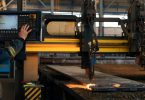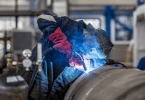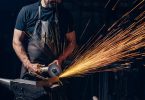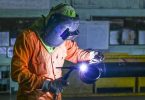It’s dangerous to even think about welding without a helmet. You might be surprised to know I actually did that and had a terrible experience I must say! It was just a simple repair job that wasn’t supposed to take much time. I used my hands to shield the weld and after a few minutes, my face felt like it was on fire! A burning sensation gripped my eyes too. That’s it – I knew I urgently needed a welding helmet to save my eyes and face from burning. I couldn’t afford to repeat this mistake again!
After trying out several welding helmets, I have now realized the other factors associated with using such type of headgear and what are the necessary features that your helmet should have for a better welding experience. Here the Drillly team has picked the top 10 choices to help you find your perfect welding helmet from so many alternatives.
Top 10 Best Budget Helmets for Welding
01 YESWELDER Welding Helmet EH-101H (Top Pick)
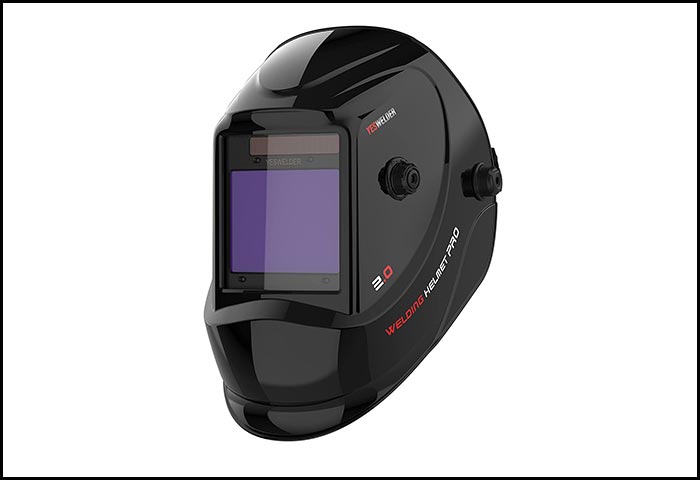
This welding helmet from YESWELDER tops our list for many reasons. It comes at an affordable price but doesn’t compromise on the quality at all! It gives you a clear view with a viewing size of 3.93″ X 1.67″ and two separate premium sensors.
EH-101H’s optical clarity is nearly perfect with a 1/1/1/2 rating. Its sensor is so amazing that you won’t even realize when it went dark while welding. What’s more, it comes with replacement lenses that many others don’t.
We found this pivot style headgear lightweight and really comfortable to wear for a long time. It’s super adjustable and looks nice too. Its grinding feature will make you more comfortable during grinding work.
This cool helmet gives you pretty decent protection. It’s all powered by a lithium battery and solar cell panel. The battery is not rechargeable but you can easily charge it up in sunlight if the battery gets dead.
EH-101H model is one of the highest-rated welding helmets on Amazon and we could really see why when we put it into the test. What we did not like was that it fogged up inside the glass after some time of use and we had to clear it up. But its long durability, great features, and pricing make it an exclusive choice that every welder deserves.
Specifications
- Viewing Area: 3.93? x 1.67?
- Arc Sensors: 2
- Weight: 1.75 pounds
- Optical Class: 1/1/1/2
- Shade Range: 4/9-13
- Lens Reaction Time: 1/10000 sec
- Power Supply: Solar & one lithium battery
Pros
- Good price
- Lightweight
- Optical clarity
- True color display
Cons
- Irreplaceable battery
Our Verdict
YESWELDER EH-101H is a great welding helmet for those that want to do their welding job comfortably with clear vision. It would be a good choice even for the beginners to start off with. And hey, it’s one of the lightest model for sale. We’d say, if you’re looking for an affordable welding helmet that will give you overall good protection, this is the choice for you!
02 Lincoln Electric Welding Helmet 3350 Series (Professional’s Choice)
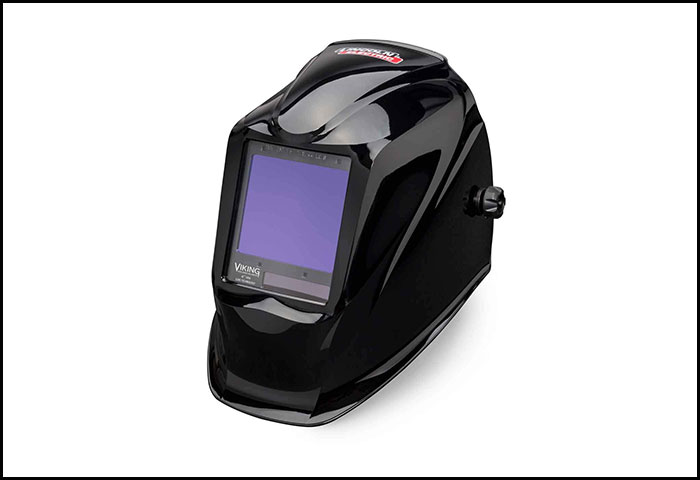
This one from Lincoln Electric is a bit expensive compared to our top pick but it will be a great option for the professionals. It has a huge viewing area of 3.74? x 3.34? that every welder will appreciate. On top of that, it offers the perfect 1/1/1/1 optical clarity.
The 3350 series has variable shades ranging from 5-13, with a lens reaction time of 1/25,000 second. It has a 12.5 square inch auto-darkening (also known as ‘auto-dimming’) lens with four arc sensors. The 4C technology shows a natural lens that increases your visibility.
This lightweight X6 headgear reduces your pressure and keeps you safe for long working hours. It comes with a universal size and we loved the fit! It’s made with thick plastic and can withstand heavy things dropped on it. So we can say it’s durable too.
The auto-darkening lenses easily adjust in both bright and dim lighting conditions. You can work comfortably indoors and outdoors. Part of the reason we loved this model was that it offered a 3-year warranty with a replaceable battery.
Specifications
- Viewing Area: 3.74? x 3.34?
- Arc Sensors: 4
- Weight: 3.20 pounds
- Optical Class: 1/1/1/1
- Shade Range: 5-13
- Lens Reaction Time: 1/25, 000 sec
- Power Supply: Solar & one replaceable li-ion battery
Pros
- Large viewing area
- Perfect optical clarity
- Natural lens color
- Lightweight
- Durable
Cons
- Relatively expensive
Our Verdict
This Lincoln 3350 series is the second-highest expensive model on our list but it’ll be worth your every penny. The optical clarity that it offers is unmatchable. It can be used for all kinds of welding, no wonder why it’s one of the best-rated models on our list. So we’ll really suggest that you give it a try if you’re buying a welding helmet for professional purposes.
03 YESWELDER Welding Helmet LYG-M800H (Beginner’s Choice)

YESWELDER LYG-M800H is a great choice for beginners, especially for its super large viewing size of 3.93″X 3.66″. It also has 4 premium sensors with better adjustments than our first choice that is from the same brand.
If you’ve ever had trouble seeing what you’re welding, you’ll definitely appreciate this headgear. Its optical clarity is the same as our top pick that we found nearly perfect.
The pivot style lightweight headgear will give you superior comfort. Its grind and cut mode allows you to work in all conditions.
Its lens reaction time from bright to dark is 1/10000 seconds. However, the lens may take longer to switch back from dark to light once you stop welding. Light leaks are a common issue we found when working with it.
It’s powered by both rechargeable batteries and the solar system. The best part is that it comes with two extra replacement lenses, one replacement battery and a carry bag. It doesn’t cost much compared to the features it has.
Specifications
- Viewing Area: 3.93? x 3.66?
- Arc Sensors: 4
- Weight: 2.2 pounds
- Optical Class: 1/1/1/2
- Shade Range: 4~5/9-9/13
- Lens Reaction Time: 1/10000 sec
- Power Supply: Solar & one replaceable lithium battery
Pros
- Super large viewing area
- Optical clarity
- Comfortable
- Lightweight
- Low price
Cons
- Could cause light leaks
Our Verdict
LYG-M800H comes with an excellent package at a low price. The new users will find it really comfortable to use. You will enjoy its large viewing area. If you are a first-time buyer or do weld occasionally, this is for you!
04 ESAB 0700000800 SENTINEL A50 Welding Helmet (Durable choice)
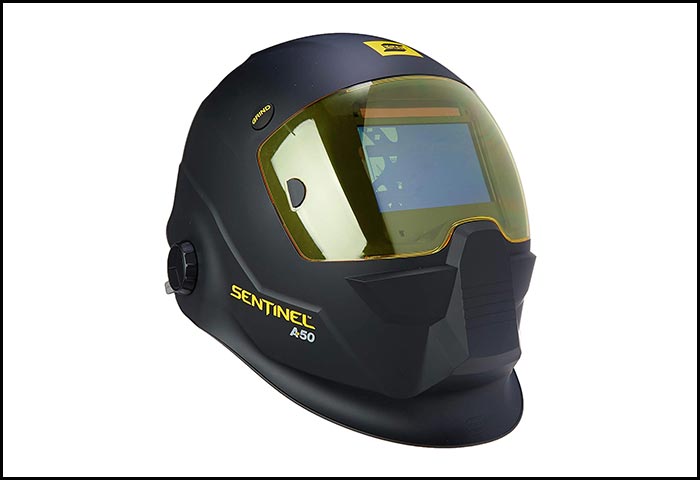
The ESAB SENTINEL A50 welding helmet’s design is inspired by the helmets in the Halo video game. It has some cool features, including super-comfortable headgear. Its central pivot point allows you maximum head clearance when you’re welding in an upward position.
This one is great for optimum protection of your eyes and face with a fixed glass shield and safety goggles. The lens clarity is so well with the 1/1/1/2 rating. The true colors lens technology makes it easily adjustable.
It has a backlit LED touchscreen control panel with color options and eight memory settings for different jobs. We loved this feature. There’s also an easily accessible shade-4 grind button located on the exterior of the helmet. It is easy for both amateurs and professionals to use this helmet.
Like most other high-quality helmets, it has four sensors. It requires two lithium metal batteries which last for a longer time than generally expected from a welding helmet.
The cool-looking front lens is easy to change but pricey. However, the hood is durable and can withstand pressure or scratch while safeguarding all the high-tech features.
Specifications
- Viewing Area: 3.93? x 2.36?
- Arc Sensors: 4
- Weight: 1.4 pounds
- Optical Class: 1/1/1/2
- Shade Range: 5-13
- Lens Reaction Time: 1/25000 sec
- Power Supply: Solar & two replaceable lithium batteries
Pros
- Comfortable headgear
- Optical clarity
- Replaceable front lens
- Color touchscreen control panel
- Memory functions
Cons
- Relatively expensive lens
Our Verdict
If you’re a fan of ‘Halo’ video games, you’ll definitely love the look of this helmet just like us. Apart from its cool look, it has high-tech features with good optical clarity. Though expensive, these cool features and amazing durability will be worth the cost.
05 Lincoln Electric K3034-4 VIKING 3350 (The Most Comfortable Choice)
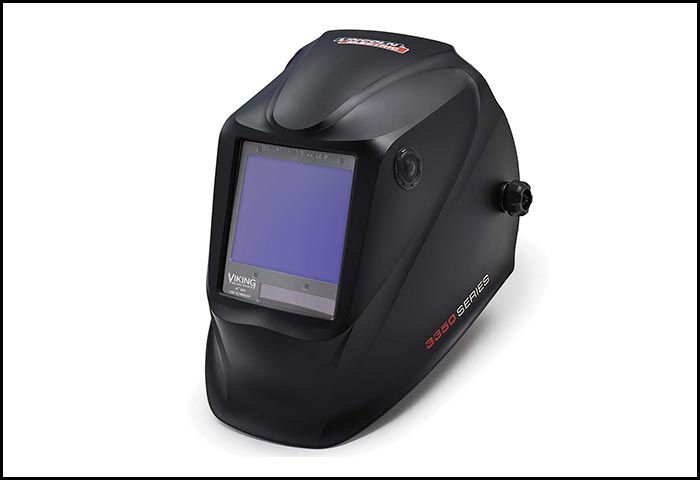
This is one of the top-rated helmet series from Lincoln Electric. This high-quality model comes with an improved X6 headgear, providing a better fit and greater comfort to welders. It should be the perfect choice for you if you want to upgrade your beginner’s level helmet.
This model features 4C-lens technology with true color and a clear view. This will reduce your eyestrain by making the arcs crystal clear. Moreover, it has the perfect optical clarity with 1/1/1/1 rating.
It has an extra-large auto-darkening lens of 95 X 98 mm that increases your viewing area. Not only does this large viewing area help you increase your productivity, but it adds greater safety as well.
The grind button situated externally allows you to switch quickly between weld mode and grind mode without even removing your helmet. You can adjust the shade of the helmet from 5 to 13 according to the type of welding you are doing, your position, and your welding angle.
It uses two CR5 batteries and is solar-powered. The batteries are replaceable though that you can easily remove and replace. On top of everything, it gives you a hassle-free warranty of 3 years!
Specifications
- Viewing Area: 3.74? x 3.34?
- Arc Sensors: 4
- Weight: 3 pounds
- Optical Class: 1/1/1/1
- Shade Range: 5-13
- Lens Reaction Time: 1/25000 sec
- Power Supply: Solar & two CR5 batteries
Pros
- Comfortable to wear
- Wider lens
- Long warranty period
- Perfect optical clarity
- Magnified cheater lenses
Cons
- Heavyweight
Our Verdict
A great welding helmet for welders looking for comfort. We loved how easily we could adjust the headgear to fit and switch its different modes. This was also a highly rated product by Amazon users and we have good reasons to keep it among our top 5 choices. A longer warranty period is definitely a plus besides other magnificent features.
06 3M Speedglas 9100 06-0100-30SW (High-End choice)
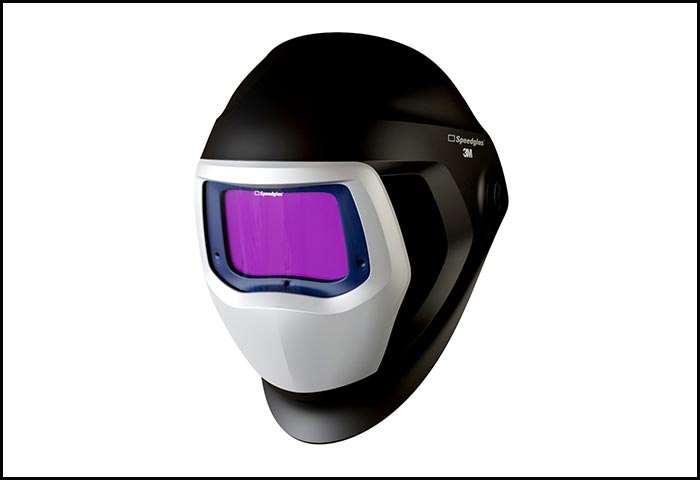
Next up is our high-end choice that we recommend for advanced users with a good budget. This is the most expensive welding helmet on our list but with the most amazing features with a stylish outlook.
3M Speedglas welding helmet has one of the largest viewing areas available; i.e., 2.8 x 4.2 inches. You will get the most amazing viewing experience with its most exclusive feature – the side windows available inside this helmet.
It has shades from level 8-13 that offers you many variabilities. It includes three arc sensors. The sensitivity adjustment feature lets you handle all the stick, MIG, and TIG welding processes along with a torch and grinding modes. Remember that this company produces 9000v helmet outside protective sheild. So, in terms of protection, it’s sufficient.
This headgear is durable because the mask is made of polycarbonate that’s known to have great heat-resistant properties. This newly improved lightweight headgear is easy to wear with its two adjustable head straps and has a good fit.
We found it quite comfortable to put on and easy to operate. The only drawback we noticed was its high price and not supporting solar power. It works with two replaceable lithium batteries.
Specifications
- Viewing Area: 4.2? x 2.8?
- Arc Sensors: 3
- Weight: 2.09 pounds
- Optical Class: 1/1/1/2
- Shade Range: 5, 8-13
- Lens Reaction Time: 1/10000 sec
- Power Supply: Solar & two replaceable lithium batteries
Pros
- Large viewing area
- Side windows
- Lightweight
- Durable
Cons
- Expensive
- No solar power
Our Verdict
This professional quality welding helmet is our high-end choice, thanks to its awesome features. As mentioned above, it was the most expensive one on our list and consequently, it got fewer reviews, but most of the reviews were great. We also had a positive experience with this top-of-the-line welding helmet. Try it out and you will surely find that this was a good decision.
07 Antra Solar Power Welding Helmet AH6-260-0000

Our 7th pick is the most reviewed welding helmet on our list and comes at a low price. Antra AH6-260-0000 weighs only 1.00 pounds, making you comfortable to wear it for long hours. The auto-darkening feature protects your eyes well. It can be turned off before welding when you are handling any grinding work. A complete automatic power option is available with this headgear.
It protects your eyes with an extensive shade range within 4/5-9/9-13 to visible lights. The viewing size is 3.86? x 1.73?, which is pretty good actually. In fact, it has a 1-1-1-2 optical clarity rating similar to the Esab SENTINEL.
Antra AH6-260-0000 is a nice choice for basic operations rather than professional purposes. It has many cool features for the price. Due to its solar power facility, you do not entirely have to rely on batteries. We think this is a great budget option that should be in your consideration.
Specifications
- Viewing Area: 3.86?x 1.73?
- Arc Sensors: 4
- Weight: 1.00 pound
- Optical Class: 1/1/1/2
- Shade Range: 4/5-9/9-13
- Lens Reaction Time: 1/25000 sec
- Power Supply: Solar & 2 replaceable lithium batteries
Pros
- Affordable price
- Solar-powered
- Very lightweight
- 4 sensors
- 1-1-1-2 optical clarity
Cons
- Not suitable for professional use
Our Verdict
“What is a good cheap welding helmet?”, you wonder. Well, we give you AH6-260-0000. Compared to Lincoln 3350 and Esab SENTINEL, it is a good helmet at a much lower cost. It may not have a good lifespan, but it certainly ticks off a lot of boxes that you desire in your welding helmet. And who doesn’t love budget-friendly products!
08 DEKOPRO Welding Helmet
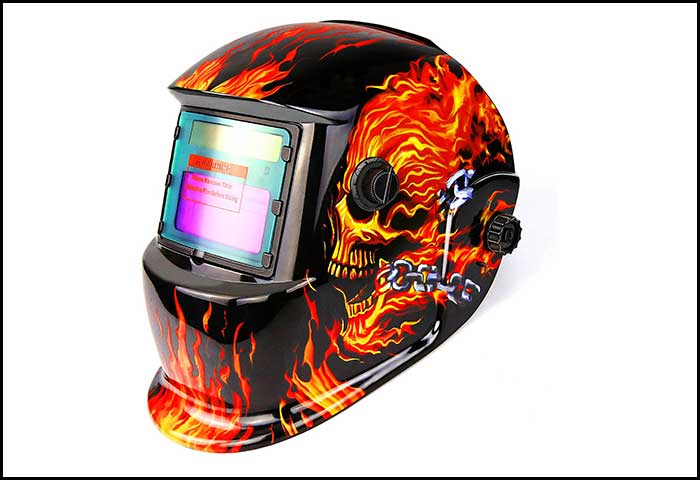
This DEKOPRO model has the lowest price tag on this list while the skull design is really cool and eye-catching.
This headgear is lightweight with well-rounded edges that won’t hurt your neck. The adjustable headband makes it easy for you to fit it comfortably on your head.
It comes with an average viewing area of 3.62’’ x 1.65’’ that gives the user a good view with 180 degrees’ rotation. The optical clarity has a 1/2/1/2 rating that might not give you a crystal clear view but is standard. It comes with a limited shade with a range from 9-13.
The battery life is 5000 hours that we think is pretty good for the price. It’s also powered by the solar system. So overall, the power system will last a long time.
It’s made of materials that are durable like other high-rated helmets. The 4 sensors work great and the auto-darkening filter switches from light to dark in just 1/25000 sec. You can use this for industrial as well as personal purposes.
Specifications
- Viewing Area: 3.62? x 1.65?
- Arc Sensors: 4
- Weight: 1.6 pounds
- Optical Class: 1/2/1/2
- Shade Range: 4/9-13
- Lens Reaction Time: 1/25000 sec
- Power Supply: Solar & one CR2 battery
Pros
- Cost-effective
- Long battery life
- 4 sensors
- Optical clarity
Cons
- Average viewing area
- Limited shade variability
Our Verdict
DEKOPRO Welding Helmet is inexpensive but doesn’t compromise with the quality. Overall, all the features that this welding helmet has are standard according to ANSI. The auto-darkening feature is simply amazing with a super sensor speed. For the money, you can’t really go wrong with this one!
09 Honeywell Fibre-Metal Pipeliner Fiberglass Welding Helmet 110PWE
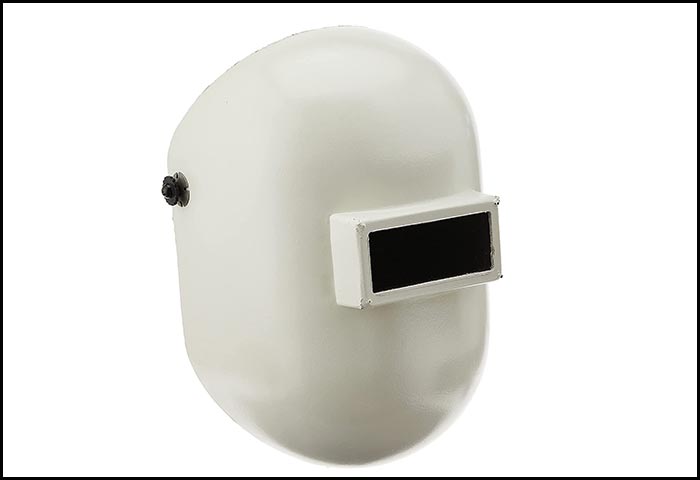
This welding helmet from Honeywell is unique in design and ranks 9th position on our list. It is made of fiberglass. The tough SuperGlas Plus material prevents cracks and its impervious quality doesn’t allow moisture. The smooth surface has a self-extinguishing trait that deflects sparks.
This pipe welding helmet is designed in such a way that it has access to smaller places where other standard helmets won’t fit. If you have to weld in congested places, this is your choice.
For those who want their welding helmet lightweight, this one is great because it weighs only 2 pounds. The constant-fit rubber headband is easily adjustable and you can easily have your right fit.
The best thing about this pipeliner welding helmet is that it has a 2″ x 4″ shade 10 lens that ensures maximum eye protection by filtering out 100% IR and UV wavelengths.
However, we were not very impressed with the finish and we noticed an unpleasant smell that vanished after a few weeks of luckily. And we don’t have any complaint about it’s old school design (Iron-man helmet shaped), it’s functionally ok.
Specifications
- Viewing Area: 4.25? x 2.00?
- Arc Sensors: 0
- Weight: 2 pounds
- Shade: 10
- Material: Fiberglass
- Power Supply: Solar
Pros
- Comfortable
- Affordable
- Good lenses
- Great fit
Cons
- Unpleasant smell
Our Verdict
This pipeliner welding helmet has a great rating – a telltale sign that most users had a pleasant experience with it. We liked all the features except for the poor finish quality. It protects your face and eyes from radiation and sparks and fits well on your head. If you prefer quality over appearance, you should be confident in purchasing this helmet.
10 TACKLIFE Welding Helmet PAH03D
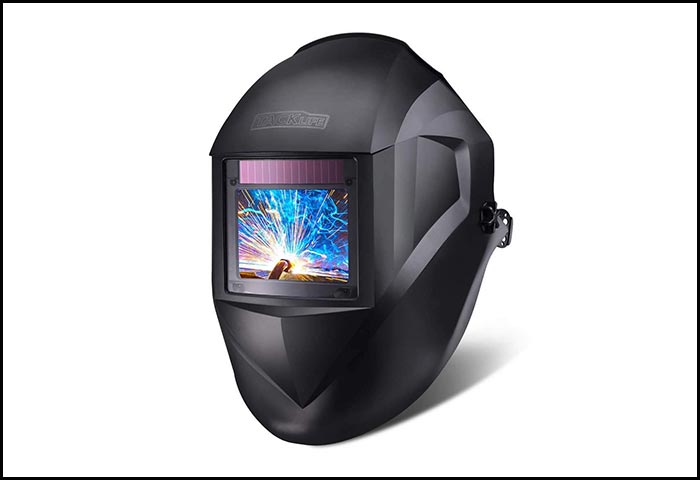
This TACKLIFE welding helmet is the last on our list but doesn’t have the least number of features. It actually comes with advanced configuration settings.
It has a large viewing area of 3.94″x2.87″. Though the viewing window is not so wide, you’ll have a crystal clear view with its perfect optical clarity with a 1/1/1/1 rating. A great and clear view will definitely have a good impact on your productivity and quality of work.
This hood can be comfortable for you to work for long hours because it weighs less than 1 pound – 14.1 ounces to be precise.
For those who are more concerned about eye protection, this is safe enough because it offers DIN 16 UV/IR protection.
TACKLIFE PAH03D is equipped with 4 premium arc sensors that have an impressively quick response time. It switches from light to dark in 1/25000 sec. We loved the auto-darkening lenses of this welding hood.
Specifications
- Viewing Area: 3.94?x2.87?
- Arc Sensors: 4
- Weight: 14.1 ounces
- Optical Class: 1/1/1/1
- Shade Range: 3/3-8/9-13
- Lens Reaction Time: 1/25000 sec
- Power Supply: Solar & one lithium battery
Pros
- Cost-effective
- Perfect optical clarity
- Lightweight
- 4 premium sensors
Cons
- Small viewing window
Our Verdict
Although we placed this model in the last place on this list, it’s no less than the other budget-friendly helmets we reviewed. The optical clarity and four great sensors with a quick reaction time are features usually found in more expensive models. This PAH03D badass model from TACKLIFE is a great value for your money!
Welding Helmet Buying Guide: What to Look For
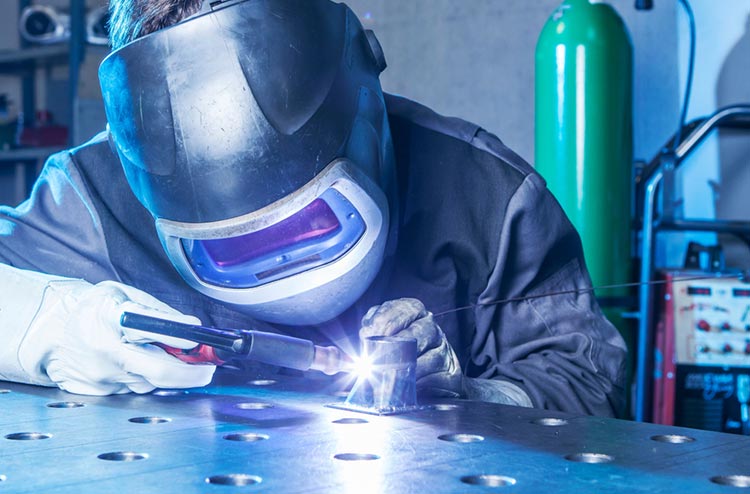
Welding helmets (vastly misspelt as ‘helets’) are essential protective gear and you got to have some basic ideas about them before planning to get one. Let’s get to know
1. Size of Viewing Area
The size of the viewing area is a major purchasing consideration. There is no right size and the preference varies from user to user. The amount of out-of-position welding could also have a role to play here.
Generally, the view sizes could range from 6” to 9” depending on whether you are using it for your home-based project or for commercial purposes. The auto-darkening models measure 97x 62 mm (3.82 x 2.44 inches) or larger.
2. Lens or Visor Type
- Auto-Darkening
Auto-darkening lenses get dark instantly when you start the torch and vice versa. They possess a liquid-crystal display similar to a TV screen and can be used either with batteries or a solar system, or both can be combined.
- Passive darkening
Fixed-shade glasses are used in passive lenses that are coated with UV as well as IF protection. While torching, passive lenses usually ensure better visibility. The best part is that they are cheaper and can be easily replaced. They also don’t require batteries or sensitivity controls.
3. Lens Shading
- Variable Shade
Some welding helmets come with variable shades – some shades are transparent while some are darker. The brighter the electric arc, the darker you need your lenses to be. The shades usually vary from 6-13 but you may have to use the number 5 if you are welding with low amps.
- Fixed Shade
With the fixed shade number, you have limited options and you will be able to use it in specific conditions only. You’ll need a higher number if you are welding with higher amperage and lower in case of a lower amperage.
4. Power
- Solar Power
This can be the cheapest and the best option for welding helmets. They require a little amount of power to operate. But if you’re going to use your helmet for a long period of time, you better consider battery power.
- Battery Power
Most welding helmets are powered with rechargeable internal batteries. This option helps avoid dangerous wire around while you’re welding.
5. User-Replaceable Batteries vs. Non-User Replaceable Batteries
Some welding helmets feature user-replaceable lithium-ion batteries while others feature non-user-replaceable batteries. The former has the potential for a longer service life when compared to the latter that generally lasts around five to seven years.
6. Lens Clarity
The clarity of the lens is another major factor to consider besides the viewing window size in order to see well what you are working on. Lenses are given a rating of 1-3 in four tested areas where 1/1/1/1 is a perfect score in terms of clarity.
7. Size, Fit, Color & Graphics
In terms of color, you get a whole bunch of choices from unique airbrushed graphics, stickers and classical color schemes. Most dominant colors are blue, metallic silver, brass, gold, black, grey, pink and red.
Welding helmets come in both large and small sizes and light and heavyweights. You should make sure your chosen helmet fits your head.
Another aspect of the size is that it’s an inseperable part of the design. There are plenty of designs and shapes out there. The classic sugar scoop (minion shaped) and pancake designes have been replaced by modern crazy super hero and super villain (Predator) characters, for example: Star Wars character (more commonly- Darth Vader) helmets and other unique designs including camo and rebel flag. Also, the flip front or snap on models have an appeal to pragmatic users.
8. Material & Durability
Welding helmets made with materials like tinted glass, carbon fiber, resin, fiber metal, tinted plastic or a variable-density filter are more durable.
9. Reliability & Comfort
No matter how comfortable your helmet is, if it doesn’t keep your eyes and skin safe then it will be of no use.
10. Grind Mode
Sometimes you would use your helmet as a mask for face protection only and not block the light. This is the reason some masks come with the grind mode feature.
11. Cheater Lens
A cheater lens is a small magnifying lens that helps enlarge what you are looking at. Few such headgears actually come with this feature.
12. Numbers of Sensors
Some auto-darkening models may feature sensors that help detect flashes and darken the helmet instantly. The presence of four sensors decreases the risk of catching flashes. So, it’s better not to have less than four sensors.
13. Safety Standards
The American National Standards Institute (ANSI) has outlined some safety guidelines to ensure welders are protected. Check to see if your preferred helmet conforms to the current safety standard set by the ANSI Z87.1 – 2003.
14. Overhead welding
For overhead welding, your vision needs to be really clear and you should be able to move fast. Get a lightweight hard hat helmet for this purpose.
15. Personalization
You have the opportunity to customize your welding helmet’s color or add unique visuals that show you’re not new to welding. Custom models are always exciting and unique and there’s always the freedom to
16. Lens Reaction Time
This is the speed at which the lens changes from light to dark after the initiation of arc. The high-end models usually take the minimum amount of time possible.
17. Respirator Systems
It is best for you to buy a helmet with a dust shield inside. This is necessary because you will have to stick your head inside the small space in the helmet and move while welding. Also, make sure you have access to a lot of fresh air when the helmet is on.
18. Warranty
You can expect a 3-year warranty from your choice if you get a high-quality one. This is the average period that most of today’s helmets come with.
19. Budget
There are many models ranging from $30 to $500. Your budget will determine the quality you will get. Whatever your budget is, we recommend you to save some for buying othere safety accessories like supplied air respirator, gloves and glare cover.
Care & Maintenance Tips
You need to take good care of your welding helmet because it’s the most important safety equipment for a welder. Your welding helmet protects your eyes, face, and respiratory system after all. So, you can’t be careless about its maintenance because your own safety counts here.
- Maintain a regular schedule to clean your welding mask. You can use a number of materials for this purpose, such as lens cleaner wipes, multipurpose cleaning brushes, gentle air cleaners, soft cotton towels, baby wipes, and clear gear disinfectant sprays.
- Never clean your filters using compressed air. This may create holes in the filter that will harm its filtering capacity. Change the pre-filter regularly though this can be a bit expensive.
- Always carry your helmet in a helmet bag. This is necessary to protect the lenses from scratches. The purple coating on your lenses blocks UV/IR, so it’s necessary to make sure the lenses are not scratched or damaged.
- The cover lenses of your helmet go through the most ‘tortures’ and that’s why you need to change them as soon as they get damaged to maintain your clear vision. You should also inspect frequently whether your helmet has any crack or damage in order to ensure complete protection.
Welding Safety Tips
Welding exposes you to many risk factors that could cause physical harms. So, it’s really important that you take some safety precautions during your operation. Keep these factors in mind and you’ll be safe and sound.
- Read the manual containing safety information
- Make sure the helmet fits you right and you are always comfortable
- Use auto-darkening helmets since they provide you with the best eye protection
- Wear a helmet with UV protection or you can wear UV protective safety glasses under your helmet
- Button up your shirt and make sure your skin is not exposed to IR and UV rays
- Wear flame-resistant clothing
- Use respirator or exhaust hood to ensure clean breathing
Wrapping It up
We provided you with a comprehensive and detailed guide about choosing the right type of welding helmet that suits your needs the most. We picked some of the highest-quality welding helmets to assist you in finding your ideal model and make your welding job easier. After reading our reviews, you know which factors should be considered before purchasing a welding helmet and which are the top-rated welding helmets on the market.
Our first pick YESWELDER EH-101H should be a standout choice with its modest price and top features. For those in need of an advanced model, Lincoln 3350 Series is a great option. Equipped with one of the largest viewing windows and high shade variability, you won’t regret purchasing this headgear.
We hope you have already decided on the best choice for you. Remember about your budget and specific needs. Happy shopping!
FAQ
1. How dark should my welding helmet be?
Ans: It depends on the type of welding you’re doing. The more amperage you use the darker shade you’ll require to ensure that your eyes don’t get burned. We recommend you to use a shade between 8-10 for lower amperage and 10-14 for higher amperage.
2. What welding shade is darker?
Ans: The higher the shade number, the darker the lens is. Shade 14 is the darkest shade available till date but this shade is not available in most welding helmets. Typically, your auto-darkening welding helmet will go up to shade 13.
3. What shade of welding lens should you use for MIG welding?
Ans: The recommended shade for MIG welding is between shade 10 to 13. The shade number increases with the increase of amperage and vice versa.
4. What is the ideal lens size on a welding helmet?
Ans: For basic welding jobs, the standard dimension of 3.5-1.75 inches is sufficient. You should consider a larger lens for heavier welding jobs as you will require a larger view to work in different positions. In that case, the width should be more than 3.5 inches and the height should be more than 2.5 inches.
5. What is an auto-darkening welding helmet?
Ans: Auto-darkening welding helmets have special lenses made of liquid crystals. It uses light sensors that automatically switch from light to dark in around 1/25000 second, depending on the number and quality of sensors used. The settings option allows you to adjust the sensitivity, shade and delay setting.
6. Do welders go blind over time?
Ans: Yes there is a risk because of working long hours and using cheap welding helmets that give poor eye protection. UV rays keep passing through those defective lenses exposing the welders to arc radiation.
7. What is the TIG Amperage Rating?
Ans: The TIG amperage rating is an indicator of the minimum amperage necessary for the helmet to function properly. The lower rating means the lenses are more sensitive. For TIG welding, the minimum TIG amperage rating should be 10 amps.
8. How long do welding helmets last?
Ans: It depends on how often you use it and how well it is taken care of. The irreplaceable batteries usually last around 7 years and replaceable ones around 3 years. But in some cheap helmets the batteries may malfunction only after a few months. The best choice for you should be a helmet that supports both solar power and replaceable batteries.
9. How bad is welding for your eyes?
Ans: If your eyes are not sufficiently protected during welding, it can be extremely dangerous for your eyes. The radiation emitted during welding and all the extreme heat can harm your cornea and eventually lead to permanent blindness.

